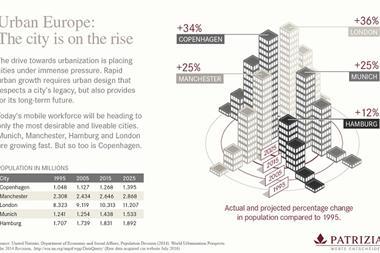The key theme this year at Mipim was urbanity – bringing increasing numbers of people in cities together through placemaking.

Our cities will undergo enormous change, with the UN predicting that 6.3 billion people will be living in cities by 2050. By 2025, it is predicted that there will be 37 megacities, mostly in China – Jing-Jin-Ji will be the world’s first city of 100 million people.
With accelerating change, cities are taking on greater importance. However, as competition for foreign capital investment in cities grows, success is no longer purely about size. Innovation, liveability and an ability to transform to a changing socio-economic landscape are increasingly important.
The World Economic Forum published a list of 110 cities for millennials. Berlin came top, followed by Montréal, London and Amsterdam. The key ingredients are: the business ecosystem – jobs; availability of essentials – housing, food and transport; openness – including gender equality and tolerance; and recreation.
Equally, we need to look after cities’ ageing populations – Hong Kong has the most rapidly ageing demographic of city dwellers.

The dominance of cities is clearly having an impact on real estate markets. The recent CBRE Global Gateway Cities report highlights that urban big data initiatives will reinforce major global gateway cities’ dominance and offer real estate benefits. They are also highly liquid markets that provide good capital protection, with European examples including Frankfurt, London, Madrid, Milan, Munich and Paris.
In this increasingly dense, high-rise, urban and technological environment, we need to create a sense of belonging, community and wellbeing for all city citizens; otherwise rapid urbanisation is not sustainable.
Big data’s impact
CBRE has two key reports that look at human interactions with cities: Urban Big Data and Placemaking.
Urban big data influences occupiers’ location decisions about quality of place, accessibility and workforce appeal. It outlines how tech and data can enhance people’s interaction with their city. Key takeaways include:
- Data collection, analysis and usage are advancing rapidly with some cities clearly leading;
- Successful use of urban big data techniques boosts real estate values;
- Urban big data initiatives reinforce major global gateway cities’ dominance;
- Initiatives pursued in smaller markets raise cities’ status and investor appeal; and
- Developers looking for new angles and enhanced returns should identify sites with the potential for value uplift from big data initiatives.
The Placemaking report reviewed 11 initiatives with a specific public realm intervention. We combined the Jan Gehl methodology, assessing human experience of place, with CBRE data, to assess the effect of public realm interventions on property values.
We found that improvements in the public realm create wellbeing and raise values by: improving an area’s overall image; creating a new destination by establishing facilities that enable greater human interaction; adding versatility; and helping establish the character for recreation, not just living and working.
Urbanity has positive impacts on the quality and human experience of urban spaces, and on property values, but ultimately that value will be in the leaders who evolve our cities of today and the city citizens and investors who back our cities of tomorrow.





























No comments yet